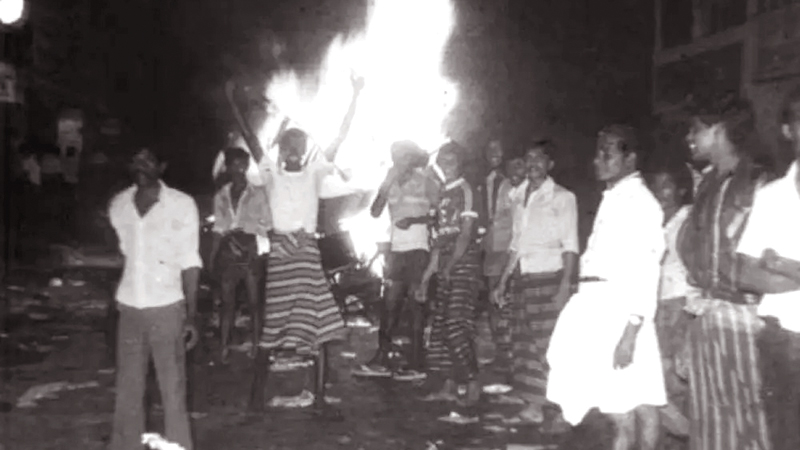 In 1983, 32-year-old Arun Chellappah was employed at the Department of Treasury. “Chellappah, who had married on July 22, arrived at work a few days later to find his colleagues murmuring quietly among themselves. As he passed by, he caught a chilling remark: ‘Maybe he’s a Tiger too.’”
In 1983, 32-year-old Arun Chellappah was employed at the Department of Treasury. “Chellappah, who had married on July 22, arrived at work a few days later to find his colleagues murmuring quietly among themselves. As he passed by, he caught a chilling remark: ‘Maybe he’s a Tiger too.’”
Upon noticing Chellappah, his visibly alarmed manager had quickly approached him. “People are talking about you. Go home soon,” he had quietly warned.
Chellappah had returned to his home on Daya Road in Wellawatte to find his wife being sheltered by their neighbours, the Robert family. It was Mr. Robert who broke the frightening news to the newlyweds, who had arrived in Colombo earlier that very day after their marriage. “Narahenpita town is on fire. Vehicles belonging to Tamils are being set alight in Borella,” he said, heightening the couple’s growing fear.
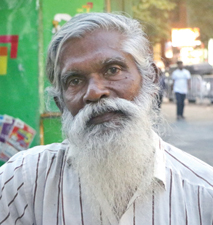
Cyril Ariyapala
Despite the danger to their own safety, the Roberts had selflessly offered shelter to the young Tamil couple, hiding them away in a room. Around 7 p.m., Chellappah watched helplessly as the first floor of his home was engulfed in flames.
The very next day, Mr. Robert accompanied the couple to the Wellawatte Police Station, hoping to ensure their safety. From there, Chellappah recalled, they were taken to Hindu College in Colombo, where over 2,000 Tamils displaced by the violence had sought refuge. They arrived with nothing but the clothes on their backs.
The following day, they were transported by bus to the Colombo Port and sent by ship to Kankesanthurai. This was just two days in the lives of Arun Chellappah and his wife, but it is a story that echoed the fate of thousands during Black July, 1983
Today, Arun Chellappah lives quietly on his farm in Jaffna. Following the horrors of Black July, he fled to Canada as a refugee and has only recently returned to Sri Lanka. The man who saved him, Robert, has since passed away but the bond between their families remains unbroken.
Before leaving for Jaffna in 1983, Chellappah entrusted Robert with the keys to his house. When he returned three months later in a lorry, he found the home untouched. Robert had made sure to protect it. Chellappah gathered only the essentials and gave the rest to Robert before making his way back to Jaffna.
But the lives lost in the markets, on the streets, and behind the walls of Welikada Prison during that fateful Black July can never be reclaimed. Those brutal days left deep scars on the nation, altering its course and plunging it into a war that would last over thirty years.
Black July 1983
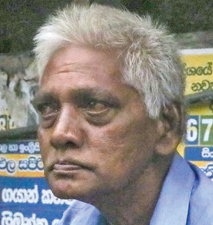
Raja
July 1983 would become a dark chapter in Sri Lanka’s history. Infamously known as Black July, an anti-Tamil terror erupted and rapidly spread across the country, marking a decisive turning point in the country’s ethnic conflict and deepening the divide between communities. The violence was sparked on July 24, following the brutal killing of 13 Sri Lanka soldiers by the Liberation Tigers of Tamil Eelam (LTTE) in Jaffna.
In retaliation, mobs reportedly sanctioned by the United National Party Government led by J.R. Jayewardene carried out organised attacks against Tamil civilians, their homes, shops, and places of worship especially in Colombo and other areas in the South.
One of the most horrific incidents during this period was the massacre at the Welikada Prison, where 53 Tamil political prisoners were brutally killed by fellow inmates allegedly with the knowledge or complicity of prison officials. These killings occurred in two waves, on July 25 and July 27, despite repeated warnings and requests for protection.
According to various reports and human rights organisations, the Black July terror resulted in the deaths of between 400 and 3,000 Tamil civilians across the island. Over 8,000 homes and 5,000 shops were either destroyed or looted, and more than 150,000 people were displaced, many forced to flee the country as refugees. The violence not only devastated lives and communities but also strengthened the LTTE’s influence, as many Tamil youths felt compelled to join the militant group marking a turning point that significantly escalated Sri Lanka’s armed conflict.
The beginning
On the night of July 24, many witnesses observed the outbreak of violence near the Borella Cemetery Roundabout. It was the first sign of what was to come. On the day of the full military funeral for the 13 soldiers, crowds had gathered as President J.R. Jayewardene initially approved the funeral plans but later decided to cancel them. In the aftermath, a faction of the crowd turned violent. They had moved towards Borella town, targeting Tamil-owned shops, setting them on fire and stealing everything inside.
Raja, who makes a living as a cobbler near the Borella bus stop, remembers the day’s events well. “No person who looted those Tamil shops lived a good life after that,” Raja said. “Three out of four of them known to me ended up addicted to drugs or dying miserably. That’s the truth,” he said.
Raja was just 15 years old during the riots. He grew up in Borella Town and saw much of what happened first-hand. “Back then, there were many Tamil shops in this area. They minded their business, never bothered anyone. We all lived peacefully. But that day, everything changed,” he said.
He recalled that mobs used cruel methods to identify Tamils. He remembered hearing that they would stop people on the street and ask them to say certain Sinhala words, judging their origins by how they pronounced them. “If they couldn’t pronounce the words properly, they would be beaten,” he said quietly. Borella, once a place of ordinary life and mixed communities, became the spark that ignited a national tragedy.
I protected them
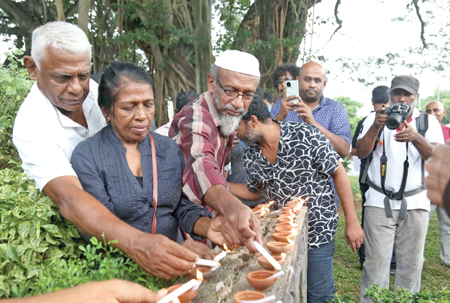
People remembering Black July
A man selling lottery tickets near the bus stop also recalled what he witnessed as a 23-year-old during the harrowing days of July 1983. Wishing to remain anonymous, he noted that speaking out after the fact seemed futile at the time.
“After someone stabs another with a knife, there’s no use saying it was wrong,” he said quietly. “He should have thought before doing it.”
According to him, the violence started soon after the bodies of the 13 soldiers killed in Jaffna were brought to Colombo.
“What people don’t talk about is that many came not just to destroy but to loot. Rice, dhal, anything they could grab from Tamil shops, they sold here for just a few rupees.” he said.
He went on to describe the chaos: “While Tamil shops were being set on fire, sometimes nearby Sinhala shops caught fire too. I saw people and even the army rushing to pour water to save the Sinhala ones.”
He also recalled an officer who tried to intervene. “There was one police officer, Abdul Gafoor, stationed in Borella. I remember he fired shots into the air near the cemetery to disperse the crowd. But the mob was too big. He couldn’t stop them.”
His final words were heavy with loss. “None of the Tamil people who were driven out of Borella that day ever came back. Some sold their properties and left. Others ran with nothing and never returned.”
Unforgotten
Siril Ariyapala, a retired worker from Nugegoda, vividly remembers the horrors of Black July 1983 as if they occurred just yesterday. At the time, he was working in Colombo Fort, and what he witnessed left scars that time could not erase.
“I was working in Colombo Fort in 1983. I saw many things with my own eyes,” he recalled. “From the overpass at the Fort railway station, I watched in horror as Tamil people were burned in piles inside the station. I saw it all from above.”
He described how Tamil-owned shops in Pettah were set ablaze, while security forces stood nearby, indifferent. “They didn’t stop anything. They just stood there like nothing was happening,” he said. “There was no proper media then just newspapers and a bit of radio news. That’s all we had.”
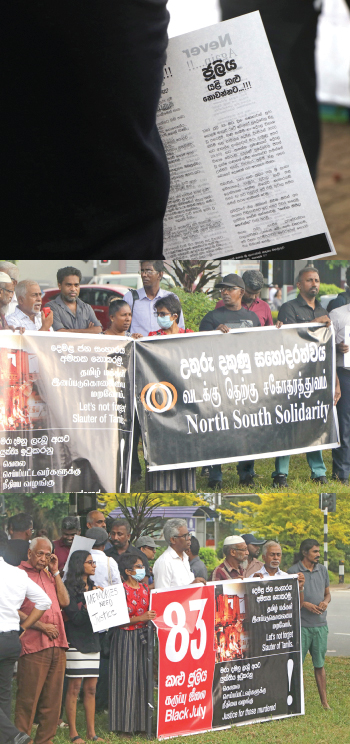
Pix by
Shabeer Mohamed
and Rukmal Gamage
He went on to recount how fear and misinformation fueled the violence. “A rumour spread that day across Colombo that the Tigers had entered the city. But I can tell you, there were no LTTE members in Colombo at that time. I never saw any. That lie was spread to turn people against the Tamil community,” he said.
That rumour didn’t stay in the city. “People took it back to their villages, and Tamil families there were attacked too,” he added. “I still remember an Air Force plane circling Colombo that day, flying very low. That image has never left my mind.”
His voice dropped as he shared one of the most haunting memories. “I saw a van on the main road in Fort. A slightly overweight Tamil man was in it with his wife and child. A group stopped them, overturned the van, and set it on fire. That man pulled his wife and child out of the flames and ran. I can still see it. That moment never left me.”
Ariyapala ended with a hard truth. “What happened that day wasn’t an accident. The Government let it happen. The violence against Tamil people was deliberate.”
Call for reflection and responsibility
On July 23, Borella transformed into a space of remembrance. Marking 42 years since the events of Black July, two separate commemorations were held, both led by South-based civil groups, both demanding justice, memory, and healing.
At Borella Junction, the North-South Solidarity Movement gathered over 50 participants under a powerful call: “Do justice to all those who were killed and victimised.” Attorney-at-Law Srinath Perera addressed the crowd, noting that while hope had risen under the new NPP Government, concrete steps, particularly around land rights and justice for victims remained elusive.
Just metres away, another event unfolded at the Borella bus stand. Organised by the Collective for a Racism-Free Sri Lanka, the group deliberately chose the location infamously tied to one of 1983’s most disturbing images of a Tamil man stripped, humiliated, and mocked by a mob. Their event, titled “Never Again, May July not be dark again,” featured trilingual poetry readings, music, and the distribution of educational materials. Dressed in black, participants stood together to declare never again should this country witness such violence.
What was striking in both events was the powerful presence of Southern voices acknowledging the violence recognising not just the brutality of that week in 1983, but its devastating legacy. These were not merely memories; they were the seeds of a war that lasted over thirty years, claimed tens of thousands of lives, and tore the nation apart.
This is not just about remembrance it is about responsibility. About transitional justice that goes beyond symbolic gestures. Real peace demands more.
If Sri Lanka is truly committed to reconciliation, it must listen to voices like Raja the lottery seller, to Siril Ariyapala, and to thousands of others whose lives were forever changed by Black July. The country must make space for truth, for accountability, and for a reconciliation that bridges the North and the South not only in geography, but also in the hearts and minds.








